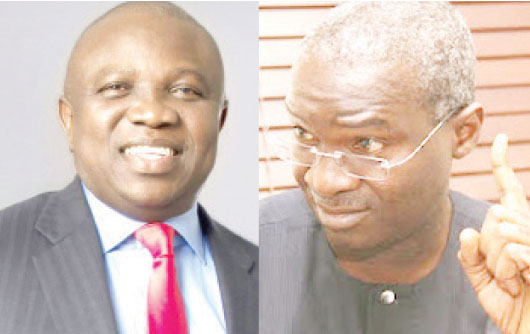Residents of Lagos, the metropolis of firsts, are seeing improvement in the illumination of the landscape, funded from the state’s N23 billion monthly internally generated revenue (IGR) and a $200 million World Bank loan.
Many roads and streets and highways have been lit up, reports Correspondent SAM NWOKORO.
Work is still in progress.
Even with that, Lagos is beginning to wear the toga of a miniature London in terms of street light.
London is reputed for its beautiful night environment. You could almost count the hairs on your head in neon lit Trafalgar Square in Central London, the world’s most cosmopolitan city of all nationalities.
Lagos had struggled with having roads and streets illuminated. Poor power supply, breakdown of the national grid, and bad urban planning made unachievable the task of making the metropolis luminous like other megacities.
Mission to solve problems
Now under Governor Akinwunmi Ambode – who took over from the pragmatic and efficient Babatunde Fashola in May 2015 – major roads and streets have been lit up both in high and low brow areas.
Ikeja GRA, the pedestrian alley adjacent to Yaba train terminus, and Ojokoro host light pillars preparatory to installation of electric bulbs.
Areas already illuminated include Mushin, Okota, Isolo, Ikorodu, and Ajeromi Ifelodun, in the Light Lagos Project planned to touch all councils in the city centre, the suburbs, and the outer fringes.
The most spectacular is the Third Mainland Bridge – the longest above water bridge in Africa – that starts at the end of the Marina on Lagos Island and bursts out around Gbagada on the Mainland.
It meanders through the front of scenic library garden of the University of Lagos (UNILAG). The illuminated bridge radiates picturesque scenery at the rear space of UNILAG and blankets the front of the garden with sparkling ambience at night.
The area has become a comfort zone for reading and relaxation at night.
A. Adedeji, the public relations officer of Lagos State Electricity Board, explained that “the Lagos Light Project is a continuation of the former Governor Babatunde Fashola’s project. Governance is a continuum.
“Every utility project such as this is continued, not interrupted. [Ambode] has decided to give attention now by upgrading the power system, the source of the energy to independent power project status.
“That means the various power systems are being upgraded from their present level in terms of voltage and carrying capacity.”
Adedeji disclosed that the state is divided into five divisions – Ibile, Ikorodu, Epe, Badagry, Ikeja, and Ibeju-Lekki.
“About 300 public roads and streets are being lit in various parts of the state and are at various stages, some completed, others nearing completion, some just being started.
“But [Ambode] has made it clear that before his first tenure finishes he would achieve 100 per cent coverage in lighting all the streets and roads in the city to reflect its mega city status.
“A total 100 new locations have been mapped for street lighting even as old ones that may have been vandalised are being rehabilitated.
“The chief source of the energy still remains independent power plants using diesel engine, generator sets, and solar in some places.”
Impact
Residents notice the impact of illumination in areas where the project has been completed.
Alfanda Street in Mushin, known for a high concentration of street urchins who hide under the cover of darkness to commit crime, is reducing in notoriety.
A resident, Desmond Nwokoro, said “this is one of the streets that the current Ambode government lighted. In Mushin here, this street is one of those rehabilitated by the Fashola government. But they did not put street light before he left office.
“It is the Ambode government that put on the street light, including the one on the Mushin to Okota road. Though the Mushin to Okota road has not been completed, as they are building it, they are putting street light at once.
“The street light has helped to reduce the incidence of bag and handset snatching at night. Not that it has stopped completely, but nowadays at least when someone sits near you and before he does anything, you would notice.
“Before, darkness was everywhere and stealing was rampant, even when there was NEPA (public power supply; acronym for the defunct National Electric Power Authority). This is because this is one of the most populated areas of Lagos.”
Another resident, who identified herself simply as Risikat, a fish seller, thanked Fashola and Ambode for lighting up most streets in Mushin.
The Seriki of Agege, Ahmed, said Agege is witnessing street light in most areas, including the axis of the popular Pen Cinema.
“It is a good development in our area. Here, most markets close very late in the night. So street light helps us a lot,” he added.
The Light Lagos campaign is more pronounced in Shomolu than in any other sections of the metropolis.
Residents on Adeola Street in Mushin expressed delight and relief.
“This street was usually dark at night. But since Ambode came to power, the streets in this area, not only Adeola Street, are witnessing a turn around and that is why you see this people at this hour late in the night.
“Before, it was not like this. I think it is a good development,” said a resident, who identified herself simply as Busola.
The light up is not limited to roads and streets.
TheNiche learnt from civil servants in Alausa that the project will be extended to housing conurbations, such as Gowon Estate, Festac, Iponri, Amuwo, and others built by the federal authorities and the state.
The plan is to achieve at least 50 per cent coverage of the metropolis before May 27 when Lagos will celebrate its golden jubilee of creation as a state.
Customised white mobile cranes bearing the name Ameritech are seen in many parts of the state mounting poles and installing lamps. Those done by the Fashola administration are being repaired in some parts.
Changing habits
Neon lit Lagos has created modern habits. There is more late night outing. And night time leisure stretches into the wee hours of the following day in some areas, even till dawn in other places.
Other activities boosted by lighted Lagos include late night trading, especially roadside trading in high population areas such as Idi-Araba, Mushin, Shomolu, Ikorodu, Okota, Makoko, and Berger where auto dealers do business transactions in the night.
Night shift duty is well noticeable in Mushin and Shomolu.
Michael Abimbola, an apprentice in a printing press in Surulere, said “since the lighting of much part of Iganmu we now work night shift because we regularly have light in the night.
“And the roads, right from our base neat Brewery to Ojulegba, is lit at night.”
Bus operators in much of these places provide services till midnight.
Focused Project
Light up Lagos is one of the major planks on which Ambode anchors his modernisation of Nigeria’s commercial hub into a megacity as envisioned by Fashola since 2007.
The project is driven by the Advisory Committee on Power which Ambode set up immediately he came into office because of his concern about rampant crime in the dark alleys of the city.
Members of the committee are Deputy Governor, Ranti Adebule; Mineral Resources Commissioner, Wale Oluwo; Attorney General and Justice Commissioner, Adeniji Kazeem; Information and Strategy Commissioner, Steve Ayorinde.
Others include representatives of Eko Distribution Company (EDC), Eko Electricity Distribution Company (EEDC), Transmission Company of Nigeria (TCN), Gas Link, Falcon Corporation, and Egbin Power.
“In view of the importance of Lagos economy to the nation and the concerns that have been expressed, particularly by the business community, my administration has considered it expedient to constitute an Advisory Committee on Power,” Ambode said at the inauguration of the committee.
“No state in the federation is more affected by the state of power sector than Lagos. In order to underscore my administration’s commitment to lives and property, we have embarked on an aggressive programme of lighting up Lagos.
“So, major highways and streets are being connected from point to point using independent power projects (IPPs) effectively.”
Why Light Lagos?
Ambode disclosed that he had received complaints about the menace of touts during dark hours.
Because of this, the committee targets high population density areas and business hubs like Berger, Lekki, Ikorodu, and most parts of Victoria Island in the first phase, which is expected to be completed in the first quarter of the year.
Ambode said the main objective is to advance the emergence of Lagos as a full blown megacity by 2020 as planned by Fashola.
Other megacity projects
Ambode wants to make Lagos a 24/7 city by 2020 in line with the aspiration of the United Nations to ameliorate the squalor of city dwellers by 2020 and provide environmental sustainability within same period.
Going by UN mandates, countries and city-states around the world are expected to provide basic social infrastructure, such as light, water, and sanitation in shantytowns to check epidemics in congested urban living.
Since the Fashola years, Lagos has been upgrading slums such as Ajegunle, Mushin, Makoko, Idi-Araba, and Ijora Badiya.
The state recently accessed the remaining $200 million World Bank loan for its transformation into a megacity status, which Ambode wants to accomplish before the expiration of his first term in May 2019.











